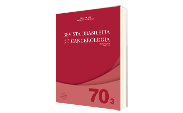Desafios e Estratégias para Mitigar os Impactos dos Desastres Climáticos nos Tratamentos Oncológicos: Aprendizados da Enchente de Maio de 2024 no Rio Grande do Sul
DOI:
https://doi.org/10.32635/2176-9745.RBC.2024v70n3.4935Palavras-chave:
Desastre Meteorológico, Oncologia, Assistência ao PacienteResumo
As consequências do aquecimento global, impulsionado pela atividade humana, têm causado impactos na saúde e bem-estar social da população mundial. Em maio de 2024, o Rio Grande do Sul vivenciou a pior enchente de sua história, trazendo impactos diretos nos serviços de saúde, principalmente no cuidado do paciente oncológico. O objetivo geral deste editorial é compartilhar desafios, estratégias e planos de ações vivenciados pelos serviços de saúde para, de forma rápida, eficaz e adaptada, garantir que os pacientes em tratamento oncológico não ficassem desassistidos, evitando influências negativas no desfecho clínico, incluindo a manutenção dos tratamentos de pesquisa clínica. As ações são baseadas na manutenção da cadeia de suprimentos, processos assistenciais e comunicação assertiva. Nesse sentido, observou-se que o acompanhamento dos profissionais de saúde que compõem a equipe multidisciplinar, voluntários, redes de apoio de outros serviços de saúde ou fornecedores e planos de contingência das instituições foram fundamentais para a continuidade do cuidado centrado no paciente.
Downloads
Referências
Ministério da Saúde (BR) [Internet]. Brasília, DF: MS; 2000. Saúde Ambiental. [acesso 2024 ago 20]. Disponível em: https://www.gov.br/saude/pt-br/composicao/svsa/saude-ambiental
Intergovernmental Panel on Climate Change. Climate change 2022: impacts, adaptation and vulnerability. Cambridge: Cambridge University Press; 2022. doi: https://doi.org/10.1017/9781009325844 DOI: https://doi.org/10.1017/9781009325844
National Geographic [Internet]. Burbank: Nactional Geographic; 1996-2015. Redação National Geographic Brasil. O que são eventos climáticos extremos e por que eles são tão perigosos? 2024 maio 10. [Acesso ago 29]. Disponível em: https://www.nationalgeographicbrasil.com/meio-ambiente/2024/05/o-que-sao-eventos-climaticos-extremos-e-por-queeles-sao-tao-perigosos
G1. Enchentes no RS: total de mortos e desaparecidos. G1, Rio Grande do Sul, 2024 jul 2 [ acesso 2024 ago 20]. Disponível em: https://g1.globo.com/rs/rio-grande-dosul/noticia/2024/07/02/enchentes-no-rs-total-de-mortos-edesaparecidos.ghtml
Bernicker E, Averbuch SD, Edge S, et al. Climate change and cancer care: a policy statement from ASCO. JCO Oncol Pract. 2024;20(2):178-186. doi: https://doi.org/10.1200/op.23.00637 DOI: https://doi.org/10.1200/OP.23.00637
Lynch KA, Merdjanoff AA. Impact of disasters on older adult cancer outcomes: a scoping review. JCO Glob Oncol. 2023;9:e2200374. doi: https://www.doi.org.br/10.1200/GO.22.00374 DOI: https://doi.org/10.1200/GO.22.00374
Man RXG, Lack DA, Wyatt CE, et al. The effect of natural disasters on cancer care: a systematic review. Lancet Oncol. 2018;19(9):e482-e499. doi: https://doi.org/10.1016/s1470-2045(18)30412-1 DOI: https://doi.org/10.1016/S1470-2045(18)30412-1
International Pharmaceutical Federation. Responding to disasters: guidelines for pharmacy 2016. Hague: International Pharmaceutical Federation; 2016.
Negi S. Humanitarian logistics challenges in disaster relief operations: a humanitarian organizations’ perspective. J Transp Supply Chain Manag. 2022;16:691. doi: https://doi.org/10.4102/jtscm.v16i0.691 DOI: https://doi.org/10.4102/jtscm.v16i0.691
Lotfi T, Bou-Karroum L, Darzi A, et al. Coordinating the provision of health services in humanitarian crises: a systematic review of suggested models. PLoS Curr. 2016;8. doi: https://doi.org/10.1371%2Fcurrents.dis.95e78d5a93bbf99fca68be64826575fa
Kovács G, Falagara Sigala I. Lessons learned from humanitarian logistics to manage supply chain disruptions. J Supply Chain Manag. 2021;57(1):41-9. doi: https://doi.org/10.1111/jscm.12253 DOI: https://doi.org/10.1111/jscm.12253
Perlino C, Daniel H, Cadwallader AB. Which drugs should be on the essential medicines list? AMA J Ethics. 2024;26(4):282-8. doi: https://doi.org/10.1001/amajethics.2024.282 DOI: https://doi.org/10.1001/amajethics.2024.282
Dolinskaya I, Besiou M, Guerrero-Garcia S. Humanitarian medical supply chain in disaster response. J Humanit Logist Supply Chain Manag. 2018;8(2):199-226. doi: http://dx.doi.org/10.1108/JHLSCM-01-2018-0002 DOI: https://doi.org/10.1108/JHLSCM-01-2018-0002
World Health Organization. Guidelines for medicine donations [Internet]. 3 ed. Geneva: World health organization; 2011. [acesso 2024 ago 29]. Disponível em https://www.who.int/publications/i/item/9789241501989
Rasheed H, Nawaz HA, Rao AZ, et al. Role of pharmacists in responding to humanitarian crisis. Enc Pharm Pract Clini Pharm. 2019:317-24. doi: https://doi.org/10.1016%2FB978-0-12-812735-3.00358-7
Salehinejad S, Jannati N, Sarabi RE, et al. Use of telemedicine and e-health in disasters: a systematic review. J Emerg Pract Trauma. 2021;7(1):56-62. doi: https://doi.org/10.34172/jept.2020.34 DOI: https://doi.org/10.34172/jept.2020.34
Toner E, Schoch-Spana M, Waldhorn R, et al. Framework for healthcare disaster resilience: a view to the future [Internet]. Baltimore: JHU; 2018. [acesso 2024 ago 29]. Disponível em: https://www.alnap.org/help-library/framework-forhealthcare-disasterresilience-a-view-to-the-future
Downloads
Publicado
Como Citar
Edição
Seção
Licença
Os direitos morais e intelectuais dos artigos pertencem aos respectivos autores, que concedem à RBC o direito de publicação.

Este trabalho está licenciado sob uma licença Creative Commons Attribution 4.0 International License.









